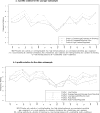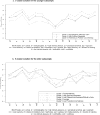Latent profile and cluster analysis of infant temperament: Comparisons across person-centered approaches
- PMID: 28758787
- PMCID: PMC5612890
- DOI: 10.1037/dev0000382
Latent profile and cluster analysis of infant temperament: Comparisons across person-centered approaches
Abstract
There is renewed interest in person-centered approaches to understanding the structure of temperament. However, questions concerning temperament types are not frequently framed in a developmental context, especially during infancy. In addition, the most common person-centered techniques, cluster analysis (CA) and latent profile analysis (LPA), have not been compared with respect to derived temperament types. To address these gaps, we set out to identify temperament types for younger and older infants, comparing LPA and CA techniques. Multiple data sets (N = 1,356; 672 girls, 677 boys) with maternal ratings of infant temperament obtained using the Infant Behavior Questionnaire-Revised (Gartstein & Rothbart, 2003) were combined. All infants were between 3 and 12 months of age (M = 7.85; SD = 3.00). Due to rapid development in the first year of life, LPA and CA were performed separately for younger (n = 731; 3 to 8 months of age) and older (n = 625; 9 to 12 months of age) infants. Results supported 3-profile/cluster solutions as optimal for younger infants, and 5-profile/cluster solutions for the older subsample, indicating considerable differences between early/mid and late infancy. LPA and CA solutions produced relatively comparable types for younger and older infants. Results are discussed in the context of developmental changes unique to the end of the first year of life, which likely account for the present findings. (PsycINFO Database Record
(c) 2017 APA, all rights reserved).
Figures
References
-
- Bridgett DJ, Gartstein MA, Putnam SP, McKay T, Iddins E, Robertson C, Ramsay K, Rittmueller A. Maternal and contextual influences and the effect of temperament development during infancy on parenting in toddlerhood. Infant Behavior and Development. 2009;32:103–116. doi: 10.1016/j.infbeh.2008.10.007. - DOI - PubMed
Publication types
MeSH terms
Grants and funding
LinkOut - more resources
Full Text Sources
Other Literature Sources
Miscellaneous



